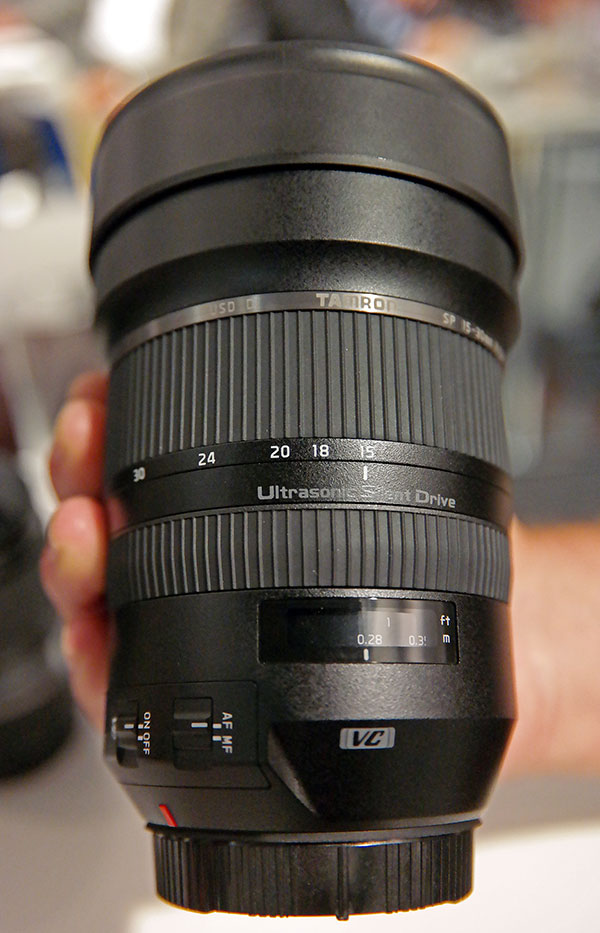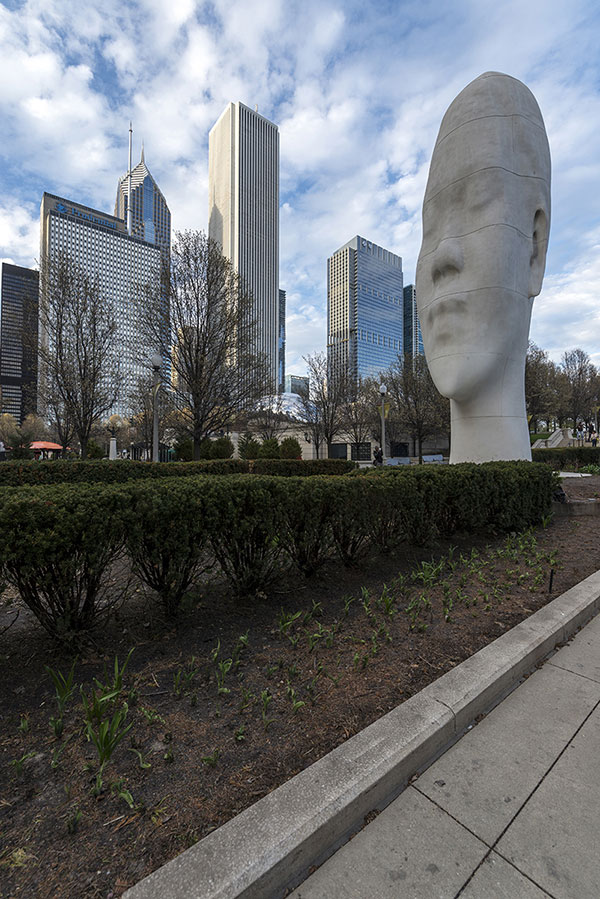Tamron SP 15-30mm f/2.8 Di VC USD Lens Review

I thought that Tamron had outdone itself first with its 70-300mm lens and then with the 24-70mm f/2.8 and 90mm f/2.8 Macro lenses: all bearing the SP (super performance), VC (vibration compensation), Di (digitally integrated primarily for full-frame sensors), and USD (ultrasonic silent drive) monikers. There are of course other noteworthy lenses in the lineup, but these are the ones I tested for Shutterbug. Now comes the impressive Tamron SP15-30mm f/2.8 Di FC USD, which the company first previewed way back at photokina 2014. With this lens Tamron has created a near-flawless masterpiece in optics that simply blew me away!
I tested this full-frame Tamron SP15-30mm f/2.8 lens on a Nikon D610, with Picture Control set to Standard (default settings). Raw images were processed first in Adobe Lightroom and, because Lightroom 5 doesn’t yet directly support this lens with a specific profile, I post-processed the files in Adobe Photoshop, which does offer a profile for this glass. Processing was carried out with sharpness at the default settings in each application. (Note: Lightroom CC now supports this lens.)
Here’s a breakdown of the Tamron SP 15-30mm f/2.8’s top features:
• Employs a complex array of lens elements designed to dramatically improve performance
• Image stabilization for handheld shooting in low light
• Multiple lens coatings against flare and ghosting
• Fast constant f/2.8 aperture with 9-bladed circular diaphragm
• Fluorine coating against water, dirt, smudges
• USD (Ultrasonic Silent Drive)
• Full-time manual focus override during AF mode
• Built-in lens hood
• Compatible Mounts: Canon, Nikon, Sony
• $1199 street price

Fast and Furious: The Tech
The Tamron SP 15-30mm f/2.8 Di FC USD is probably the company’s most advanced lens to date, featuring all its latest technologies. But what makes the lens unique is, first, that it’s an ultra-wide (or super-wide, if you will) zoom with a fast f/2.8 maximum aperture, with a 9-bladed circular diaphragm for softer, smoother backgrounds down to f/5.6.
Moreover, that aperture remains constant throughout the zoom range. Second, the lens is image-stabilized (IS), employing Tamron’s proprietary Vibration Compensation (VC) tech. You won’t find this combination among OEM products in the DSLR category (and doubtful in any other category). I know what you’re saying: Do I really need IS in a lens this wide? The answer, as my tests showed, is a qualified yes. But more on that later.
This lens sports some fancy glass, as Tamron points out: “With an optical construction consisting of 18 elements in 13 groups, including, for the first time, an XGM (eXpanded Glass Molded Aspherical) lens element placed in the front group, and several Molded-Glass Aspherical elements and LD (Low Dispersion) elements used throughout the optical system, aberrations such as geometrical distortion and lateral color are efficiently corrected enabling the zoom lens to deliver outstanding image quality throughout its entire zoom range from corner to corner.”

For more tech, there are BBAR and eBAND. What’s this, you scratch your head with a puzzled expression? These are not new—they’re Tamron’s lens coatings. BBAR is an acronym for Broad-Band Anti-Reflection coating, whereas eBAND represents Extended Bandwidth & Angular-Dependency coating. The combination aims to minimize flare and ghosting and thereby maximize the efficiency of light hitting the sensor. On top of that, a fluorine coating applied to the front element “repels water and dirt, and makes it easier to remove smudges,” according to Tamron. (Fluorine coating is finding its way into pricey glass across product lines.)
This lens also features a USD (Ultrasonic Silent Drive) ring-type motor, meaning that AF is fast and quiet, with full-time manual focus override. You’ll also note that focusing is internal. And if you look closely, you won’t see the lens barrel changing length as you zoom. But look under the (built-in lens) hood and you’ll see movement—and you’ll see a secondary built-in lens hood (Tamron says it’s for added durability). This design inherently precludes the use of any front-mounted filters.
In the Field
The Tamron 15-30mm f/2.8 is a heavy lens and large of girth, yet at no time during the hours I walked around with it attached to my Nikon D610 slung over neck and shoulder (via a sling strap) did I feel any discomfort. And holding camera and lens in my hands for a prolonged period while waiting for people to move out of the shot was easily tolerated, within reason.
In terms of zooming, the Tamron 15-30mm f/2.8 lens was a little stiff and uneven. When shooting videos, I’d plan my shots carefully, but for stills, that was no problem. More importantly, manual focusing, with the lens set to MF or AF, was buttery smooth, and that’s what really counts for stills and video. And thanks to that f/2.8 aperture, AF was fast and effortless, even in dimly lit surroundings, and for close ups.
Speaking of close-ups, I was pleased with how close I could get with this lens, within inches of the front element (with due caution exercised—remember that bulging glass), which let me easily capture a tightly focused shot of a hibiscus.
Generally speaking, don’t plan on using the camera’s built-in flash with this lens, as the built-in hood will block a portion of the light in a very pronounced way. Not to mention, light coverage will be inadequate at extreme wide angles. You’d do best using a diffused or bounced shoe-mount flash, unless you’re in a tight spot and need a fill light fast.

Performance & Image Quality
A minor amount of curvilinear distortion was evident through much of the zoom range. Barrel distortion (a bloated effect) was noticeable at 15mm, but not to a disturbing degree, and appeared to be fully corrected at 20mm. At 24mm, a faintly discernible amount of pincushion distortion (a pinched-in effect) crept in. That said, lens distortion corrections by way of Adobe RAW in Photoshop addressed the problem to my satisfaction.
I made a point of testing for flare by intentionally pointing the lens at the sun or keeping the sun just out of frame, at 15mm and 30mm. Whereas flare was not detected at 30mm, it did crop up at 15mm, in the form of flare spots (interim focal lengths were not specifically tested). Did this bother me? Absolutely not, especially since it was not of the veiling flare variety, which tends to obscure detail through much or all of the frame. Some flare is to be expected in an ultra-wide, regardless of the built-in corrections. And I should add that there are lifestyle and wedding photographers who welcome flare in their pictures.
Image sharpness and contrast were clearly astounding, with the lens delivering some of the most vivid images I’d ever seen. Even wide open, there was only a minor loss in sharpness at the corners—nothing to be concerned about. Stopping down of course helps but is not entirely necessary—feel free to shoot wide open. However, lateral chromatic aberration was evident, but was easily corrected in post. In practical terms, vignetting was not a problem, even at 15mm. And on a good day, you should be able to squeeze out up to 2 stops below the optimum shutter speed (defined as 1/Focal Length) on VC, and possibly a bit more, when shooting handheld.

Conclusion
During the course of several days, I grew to love the Tamron SP 15-30mm f/2.8 Di FC USD more and more. What I soon realized is that my 24-70mm f/2.8 optic may be a nice, all-around glass, but it pales in comparison when it comes to shooting architecture and capturing dramatic perspectives.
I became enamored of the new Tamron 15-30mm lens’s ability to render in-your-face forced perspective, exaggerating spatial relationships. I simply could not get enough of this effect. For some reason, I also found myself focusing on symmetry wherever I went and the expansive views this lens afforded me made that all the more enticing and enthralling.
With my testing concluded, I came away with the impression that this is a solid lens in terms of both build and performance. The lens gave me new insight into subjects I’d already photographed. In fact, I found myself aggressively attacking every scene with a newly inspired verve. Outdoors the 15mm focal length afforded me a revitalized perspective. Indoors I had no qualms about working in tight spaces and shooting handheld in low light, thanks to the extreme wide angle, combined with the fast maximum aperture and built-in image stabilization.

Did the Tamron 15-30mm lens’s weight bother me? Let me first point out that all images were captured handheld. Now to answer that question: no, not in the least (of course, ask me that question when I’m shooting in the heat and humidity of a tropical island).
Do I miss not being able to add a filter to the front of the lens, especially a polarizer? Not at all. Why spend time messing with filters when I could be out enjoying untold moments and countless vistas with this lens! The Tamron 15-30mm f/2.8 VC was simply a sheer delight to work with—and is a must-have in my camera bag. I highly recommend it.


- Log in or register to post comments

















































